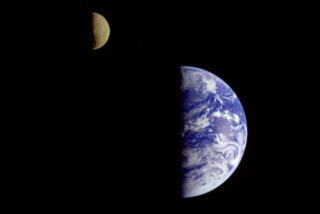Meet ‘Oumuamua, the interstellar asteroid, before it’s gone for good

‘Oumuamua is an asteroid-like object that appears to be long and thin, about a quarter-mile long and a tenth as wide.
- Share via
Astronomers have spotted an unprecedented interplanetary traveler: an asteroid-like object that came from far beyond our own solar system.
The discovery of ‘Oumuamua, described in the journal Nature, marks the first time that researchers have identified an interstellar object — and it could mean that there are many more already in our solar system just waiting to be found.
The fast-moving space rock, known formally as 1I/2017 U1, was spotted Oct. 19 by Robert Weryk of the Institute for Astronomy using the Pan-STARRS1 telescope system, which is hunting for near-Earth objects that could be hazardous to our planet. After looking back in the archive, astronomers soon realized their cameras had already picked up 1I/2017 U1 the night before. More telescopes quickly joined in the fray.
“Even with a little bit of data, this … was really unusual,” said lead author Karen Meech, a planetary astronomer at the Institute for Astronomy.
‘Oumuamua quickly revealed itself to be new to the neighborhood. It had a highly eccentric path — one that didn’t appear to be a closed orbit at all. It was also coming in from above the plane of the solar system, and its path showed that it hadn’t passed close to any of the known planets.
“Its orbit shape means it is not gravitationally bound to our solar system,” Meech said. “Now the sun certainly influenced its orbit because it passed close to it … [but] had this passed much farther from the sun, it could have effectively gone through our solar system on a straight path with no change.”
‘Oumuamua appears to be long and thin, like a cigar, about a quarter-mile long and a tenth as wide. Because it dramatically brightened by a factor of 10 and them dimmed on a regular cycle, astronomers could tell that it spun like a pencil placed flat on a table. When the narrow shaft faced Earth, it looked dim. When its long body faced Earth, offering up more surface area to reflect sunlight, it looked brighter. The object completed one of these rotations every 7.3 hours.
“We don’t have anything in the solar system that’s got this shape,” Meech said.
‘Oumuamua did not have a tail of material outgassing from its body, the way a comet does, so the object may be an interstellar asteroid.
Asteroids are the building blocks of our solar system that never quite made it into a planet — which means their contents have not been changed for billions of years. These space fossils can shed light on what our early solar system looked like.
But a space fossil from another solar system? That would give an unprecedented peek at the planetary building blocks around distant stars.
“It’s our first opportunity to look at a piece of material from another solar system up close,” Meech said. “That made it really exciting. You want to turn every telescope possible onto it and try and characterize it as best you can.”
‘Oumuamua appears to have a reddish hue, much like the material in our own solar system. That could mean that, like many of our own asteroids, it’s also covered in organic, carbon-rich material.
The asteroid was named after the Hawaiian term for a messenger or scout. But the interstellar visitor is already leaving town, speeding away at about 85,700 mph from the sun, as of Monday. It passed the Martian orbit around Nov. 1 and will blow past Jupiter’s this coming May and Saturn’s in January of 2019, headed toward the Pegasus constellation. This hasn’t left scientists much time to get an in-depth, up-close look.
The good news is that this asteroid’s appearance hints that such strange objects are far more common than scientists thought — and now that they now what to look for, they’ll be better prepared to study the next one, Meech said.
Follow @aminawrite on Twitter for more science news and “like” Los Angeles Times Science & Health on Facebook.
MORE IN SCIENCE
NASA’s dangerous Juno mission: Unravel the mysteries of Jupiter and solve the mysteries of life
A hunt for dark matter in a former gold mine
For a 3-year-old boy, a risky operation may mean a chance to hear







